Practicing Guitar Without a Guitar
Some Ideas To Improve Your Skills Without a Guitar in Hands
It may seem crazy to attempt to practice guitar when you don't have it on you. But like any instrument your guitar education goes beyond actual playing.
In fact, if you are reading this article, you probably love guitar so much you want to get better at any time or place.
In that case we will show you some methods to practice sans guitar.
Sketch Your Scales and Chords
 With so many smartphones and tablets, we forget there was a time when we wrote and sketched ideas out.
With so many smartphones and tablets, we forget there was a time when we wrote and sketched ideas out.
A bored high school guitarist in the 80s would doodle guitar fretboards with various scale and chord locations.
This was a great way to help retain the memory of all the notes.
Don't underestimate the power of good old fashion sketching out ideas on paper.
Try looking up the formulas of scales (for example Mixolydian is 1 2 3 4 5 6 b7), pick a key or root note, and fill in the location without cheating.
Or try mapping out barre chord positions, just draw any notes you can remember.
You can download a blank fretboard in PDF format here.
Visualize the Scales and Chords Along the Fretboard
And if you have no paper or smartphone, you must rely on your visual memory to map the notes, scales, and chords.
This is good practice even when you have those other items.
Imagine the notes necessary to play a piece and even mimic your hand movement along with it.
Visualization will be easier for some, if you are lucky, you may even be able to "see" the notes overtime.
The true test of imagining the notes in your head is picking out what may sound great next.
For example, being able to flesh a solo out in your head.
This is facilitated with ear training which we will mention below.
Study Tempo and Rhythm
We often spend a lot of time on scales, chords, and chord progressions.
Which is a little odd because most popular music is all the same progressions and simple melodies.
What makes a lot of music stand out is not just its pitch, but the rhythm and tempo with which it is played.
One of the best things you can do as a guitarist is study basic drum theory, and that is no joke.
You don't have to spend a fortune, just watch beginner drum styles.
Get a feel for how each genre has its own tempo range, time signature, and rhythmic qualities.
Syncopation and swing are important to master with clapping or drumming before you can strum it on the guitar right!
Knowing just four chords and a handful of funky and smooth rhythms is enough to make you a guitar Rockstar!
Learn to Read Music and Tablature
Many of you are already familiar with tablature but it doesn't hurt to take a deeper dive into more obscure symbols.
However, move on from tablature eventually and learn a little music notation.
You don't have to become an adept sight-reading composer, just learn some basics.

Know which notes are on the bass and treble clef, where the guitar stands (usually between the octaves E2-D6), learn how to identify the keys, and know your basic note values.
Much of that you likely learned in studying rhythm, so you may have a head start.
It will come in handy if you are ever struggling with a song, a quick glance at sheet music may be a lifesaver.
Find more information in our How to read music for guitar tutorial.
Ear Training
There are many courses on ear training and a variety of approaches, but each person has their own method.
First you must study your intervals, memorize the ascending and descending intervals of popular songs.
This will be the cornerstone of your ability to piece the music together.
After you begin to recognize certain intervals, scales, and chord progressions it will make it easier to play along with more improvisation.
The more you listen to music and learn theory, you will see how connected it all is and eventually playing guitar will come natural in multiple genres and styles.
You can even download this free mp3 pack for practicing functional ear training on the go.
Actively Listen to Songs
One of the number one ear training methods is to actively listen to songs.
Many years ago, there was no Internet and no massive library of educational music material.
People had to put a record on and learn it note for note.
They had to copy the pitch, dynamics, texture, and it took more patience than most can imagine.
It is also a guaranteed way to make lots of mistakes, and therefore many people do not use this method anymore.
The best way to get in the habit of doing it though, is starting on a list of songs that you know best.
You will have an easier time finding your place.
A guitar is not necessary to learn songs by ear or active listening.
When you have time, pick a random song, and break down every part of it you can without looking up tabs or chords. There is nothing else in music theory that is as important as actively listening to and copying another song.
Eventually challenge yourself with music that you do not know and are not familiar with.
Pay Attention to Other Instruments
Don't just stay obsessed with guitar; pay attention to other musicians and their instruments.
Watch the licks that bass and piano players do, listen to how the vocalist moves through a series of notes. Many famous guitar players learned new techniques by watching other musicians.
It is like learning a little drumming above, paying attention to all the instruments will let you see the bigger picture.
And seeing how simple and connected music all is will make you a better guitarist.
Use FaChords Learning Software

On this site you'll find some interactive tools that will help you learn scale patterns, chord fingerings, even chord progressions.
This fretboard game is great for memorizing the notes on the neck in a few days
Dont' tell your boss, but if you spend many hours in front of a computer while working, you could use our software and add some fun to your day.
The software runs online in the browser so you don't need to install anything!
The apps and software are great for reference and when you are first learning, but your focus on practicing guitar away from the guitar should be visualizing it or writing it down, and actively listening.
Those are the most important skills you can work on when you can't pick your guitar up to play.
Conclusions
We've just seen some idea to keep you busy and improve your skills without a guitar in
To stay updated and get access to the free download area, follow this link.